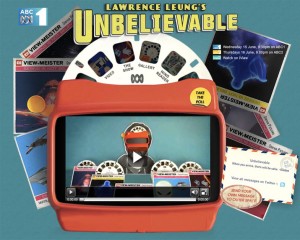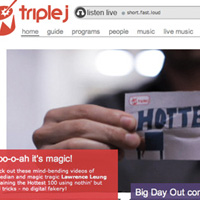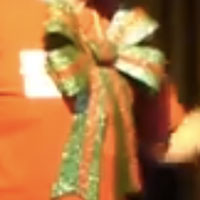Five things you didn’t know about tonight’s episode of Unbelievable
 The final episode of Lawrence Leung's hit new TV series Unbelievable aired last night in Australia. If you haven't seen it, I highly recommend checking it out here (ABC iView) before reading further, because there are spoilers below.
The final episode of Lawrence Leung's hit new TV series Unbelievable aired last night in Australia. If you haven't seen it, I highly recommend checking it out here (ABC iView) before reading further, because there are spoilers below.
...
Spoiler warning complete.
The final episode (dubbed "The Experiment") was a hidden-camera TV experiment where Lawrence and the team attempted to see whether they could turn a rational sceptic into a believer, via a carefully faked series of unbelievable events.
My job was to play the role of a parapsychology researcher. I would be pretending to be doing a standard Zener Card ESP test, while actually using sleight of hand skills to manipulate the results. The aim was to make the test subject think they were scoring anomalously highly, hopefully convincing them they were displaying ESP powers.
The episode came out really well, and was one of the most fun things I've ever worked on. As with any TV show, there was a lot happening behind the scenes that wouldn't be obvious from watching the final cut. When it comes to that segment from Unbelievable, here are just a few:
1. It was over a year in the making
Lawrence first contacted me about the series back in June 2010, at which point he'd already been working on it for a long time. The final part of the episode was filmed in September 2010, which at the time involved me taking two days of leave from my full time job to fly to Sydney for the shoot. The three months in between involved many brainstorm and rehearsal sessions as we tried to work out the best way to get the desired effect. The next ten months were spent in non-disclosure mode, having to struggle not to tell everyone about the exciting project I'd been working on. Now that it's finally aired, it's a pleasure to be able to discuss it at last!
2. It was much harder than it looked
Not only were the actual sleight-of-hand mechanics very challenging, but they were also being done in a high-scrutiny environment, for an observant and skeptical person, on camera, with almost no margin for error. Even more difficult than that though, was acting like nothing special was going on.
Though we'd spent literally months leading up to this moment, as far as Andrew knew he was just one of fifty or so test subjects being seen that day. Rather than play up the trick to be impressive, I had to play it down - acting like a bored researcher just doing his job. This went against every performance instinct I'd developed over the past decade, and we went through many rehearsals to make sure the moments were all simple and unsuspicious.
3. One-shot filming is incredibly stressful
When you're performing an illusion in a live show, even in front of thousands of people, not that much is at stake. If something goes wrong, usually there is a way to recover, or at worst there will be other chances in the show to make up for the mistake.
TV is usually even easier, since you have the luxury of multiple takes to make sure everything looks perfect. But not this time. If I screwed up, a whole week's worth of preparation and filming could have gone down the drain. Particularly since our skeptic hadn't yet been convinced by any of the other "supernatural" events, this was the last chance to nail it. If I fumbled, or he suspected anything, the whole setup could have been blown.
4. There was an "Inception" moment about half way through
There was a moment in Christopher Nolan's Inception where the team realises that Robert Fischer (the guy they're inception-ising) has been trained to have tougher dream defences than normal. The team's background checks hadn't discovered this, and now their job is going to be far tougher than expected.
Almost exactly the same thing happened on set. While explaining the structure of the test to Andrew, I showed him the ESP cards. He commented "Oh yes, I've seen those before - I used to do a lot of magic when I was younger."
Holy shit. He used to be into magic? Right there, live, in front of the cameras, on our one and only chance at getting this right, I realised that this guy was going to be much harder to fool than the average non-magically-trained person I'd been expecting. We'd been briefed at length on his personality and how best to approach him, so HOW DID THIS NOT COME UP IN THE BACKGROUND CHECKS?!
Luckily I managed to keep my freak-out from becoming visible to Andrew, and the routine we'd developed was strong enough that he didn't notice anything.
5. There was far more detail involved than you saw on TV
Though it looked like a relatively simple setup, there was an enormous amount of detail that went into making it completely believable from Andrew's point of view. Lawrence and I both have backgrounds in Psychology (BA majors at Melbourne University), and the experiences from that went into constructing a complete set of fake question scripts, answer sheets, and testing procedures. The paperwork on the desk, the exact wording of the test, and every other detail were worked out to make it seem like Andrew was just another subject in an ongoing study.
We'd even mapped out the exact statistical equations for the test, just in case he had any questions about the probabilities involved. The decision to have Andrew get 13 out of the 15 cards correct was based on a balance of wanting the result to be unbelievably unlikely, but not so perfect as to imply trickery.
...
So there you go; a few insights into one of the most challenging, enjoyable, and exciting pieces of work I've done in the past year. It was a pleasure working with Lawrence and the team, as well as being involved in a show that included appearances by Richard Wiseman, Lance Burton, Apollo Robbins, James Randi, Banachek, Tim Ellis, Mark Mayer, and many other fascinating people.
I greatly look forward to whatever the next crazy experiment will be.
Next post: Edinburgh: Laying the Groundwork »
« Previous post: I’ve Never Been Described as “Dreamy” Before…


